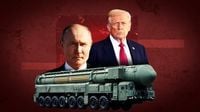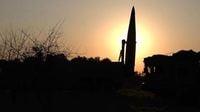In a world that has not witnessed a full-scale nuclear test in over three decades, the specter of atomic weapons is once again casting a long shadow over global affairs. Recent weeks have seen the leaders of nuclear-armed nations making moves and statements that have unsettled diplomats, scientists, and ordinary citizens alike, raising questions about whether the hard-won norms of nuclear restraint are beginning to unravel.
On October 27, 2025, Russian President Vladimir Putin unveiled a new nuclear-powered missile, boasting the capability to remain airborne far longer than conventional missiles and to evade even the most advanced missile defense systems. This public display, as reported by Inter Press Service (IPS), is widely interpreted as a bid to reinforce Russia’s nuclear might—a strategy Putin has leaned on since the outset of the Ukraine conflict in 2022. Just days later, on October 29, former U.S. President Donald Trump announced via social media his intention to resume American nuclear testing after a 33-year hiatus, instructing the Department of War to "start testing our Nuclear Weapons on an equal basis" with other countries. The timing, just before a scheduled meeting with Chinese President Xi Jinping, was no coincidence, according to experts quoted by IPS and SBS News. Many believe it was a pointed message to both Russia and China, whose expanding arsenals have prompted calls in Washington to modernize U.S. nuclear forces.
Trump’s announcement, however, was muddied by uncertainty. It was unclear whether he was referring to explosive test detonations or merely tests of weapons systems—since the U.S. has not conducted an actual nuclear explosion since 1992. In the same week, Trump claimed on CBS that China and Russia were secretly conducting nuclear tests, a claim promptly denied by China and contradicted by testimony from his own nominee to lead U.S. Strategic Command, who told the Senate Armed Services Committee that "neither China or Russia has conducted a nuclear explosive test." China’s foreign ministry spokesperson Mao Ning reiterated that China "has abided by its commitment to suspend nuclear testing."
Despite the rhetoric, Trump also floated the idea of trilateral cooperation on denuclearisation, telling reporters, "Maybe work on a plan to denuclearise, the three of us? We’ll see if that works." He added, "We’re the number one nuclear power, which I hate to admit because it’s so horrible. Russia’s second. China’s a distant third, but they’ll catch us within four or five years." Yet, as SBS News notes, all three nations continue to modernize their arsenals, fueling both hope for dialogue and suspicion about underlying motives.
Russia’s response was swift and unequivocal. President Putin ordered his top officials to prepare for the possible resumption of nuclear testing at the Arctic testing ground on Novaya Zemlya. Russian Defence Minister Andrei Belousov declared, "We must maintain our nuclear potential in readiness to inflict unacceptable damage on the enemy under any circumstances, and act appropriately in response to Washington’s actions in the interests of guaranteeing our country’s security." While stating that Russia would continue to honor the Comprehensive Nuclear-Test-Ban Treaty (CTBT)—at least for now—Belousov recommended beginning preparations for full-scale nuclear testing immediately.
The CTBT, adopted in 1996, is a landmark agreement prohibiting all nuclear explosions. Although 187 nations have signed, the treaty has not entered into force due to the failure of some key countries, including the United States, to ratify it. Since its adoption, only North Korea has conducted nuclear tests, with India and Pakistan each conducting two in 1998. The U.S. last tested in 1992, China and France in 1996, and the Soviet Union in 1990. Russia, inheriting the Soviet arsenal, has not conducted a test explosion since.
Meanwhile, the world’s nuclear stockpile remains daunting. As of June 2025, there are over 12,400 nuclear warheads worldwide, with the U.S. and Russia accounting for a staggering 90 percent—each possessing more than 5,000 warheads, according to the Stockholm International Peace Research Institute (SIPRI) and the Federation of American Scientists. China is estimated to have 600 warheads, and is investing billions in new missile systems, nuclear submarines, and hypersonic delivery vehicles, quietly shifting the global balance of power. France, the United Kingdom, India, Pakistan, Israel, and North Korea round out the list of nuclear-armed states, though each holds far fewer warheads.
SIPRI reported that in 2024, nearly all nine nuclear states moved to modernize their arsenals and acquire new missiles. North Korea, for its part, continues to accelerate its production of fissile material for warheads. The ongoing modernization and expansion are stoking fears of a new arms race, especially as the New START treaty—the last remaining arms control agreement between the U.S. and Russia—is set to expire in February 2026. While both countries have discussed voluntarily maintaining limits on deployed strategic nuclear weapons for a year, recent actions have cast doubt on that commitment.
Against this backdrop, the United Nations remains a persistent voice for restraint. Since its founding in 1945, the UN has championed nuclear disarmament and nonproliferation. It continues to rally advocates and raise alarms about the humanitarian and environmental consequences of nuclear weapons. The UN has announced plans to convene an independent scientific panel to assess the effects of nuclear warfare and an Expert Group on Nuclear-Free War Zones. During a high-level meeting on eliminating nuclear weapons in September, UN Chef de Cabinet Courtenay Rattray, speaking on behalf of Secretary-General António Guterres, warned that the world was "sleepwalking" into a new arms race, now complicated by emerging technologies and new domains like cyberspace. "The risks of escalation and miscalculation are multiplying," Rattray said.
One of the newest and most unpredictable variables in this equation is artificial intelligence (AI). As AI becomes more sophisticated and is integrated into military decision-making, experts worry about its destabilizing effects. Wilfred Wan, Director of the SIPRI Weapons of Mass Destruction Programme, told IPS that while discussions have focused on retaining human control over nuclear decisions, "this does not address other ways in which AI integration can affect the environment in which nuclear decisions are made, directly or indirectly." In 2024, 61 countries—including nuclear powers—agreed to a non-binding "Blueprint for Action" on responsible AI in the military domain, but Wan cautioned that "there are no governance frameworks specifically for the nuclear-AI nexus."
Education and dialogue remain critical. William Potter, Director of the James Martin Center for Nonproliferation Studies, stressed to IPS the importance of disarmament and nonproliferation education to "empower future generations to pursue creative ways to reduce pressing nuclear dangers." He added, "Nuclear disarmament is more important today than ever before, but it is not simply a question of securing lower numbers of nuclear weapons. At a time when the 'nuclear taboo' has been eroded and discussions about the use of nuclear weapons have been normalized, it is vital that policymakers act boldly in a fashion commensurate with the threat."
As the world marks eighty years since the first atomic bombs were dropped, the stakes are as high as ever. The decisions made in the coming months—about treaties, testing, technology, and trust—will shape the nuclear landscape for generations to come.

